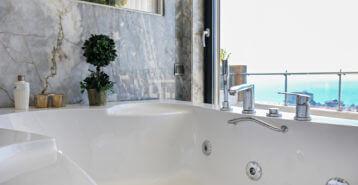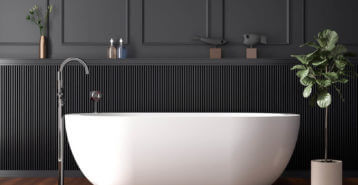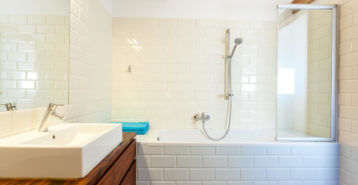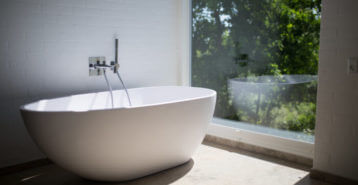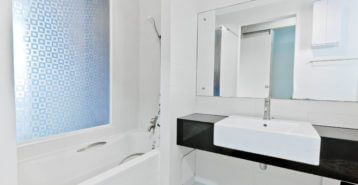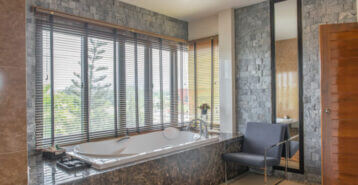The material of your bathtub not only dictates its durability and maintenance but also impacts the overall aesthetic and comfort of your bathing experience. With the right material, your bathtub can become a centerpiece of relaxation and style, enhancing both your quality of life and home value. In this guide, we’ll look at the types of bathtub materials and how to choose the best bathtub material for your own home.
Best Bathtub Material Options
Acrylic Bathtubs
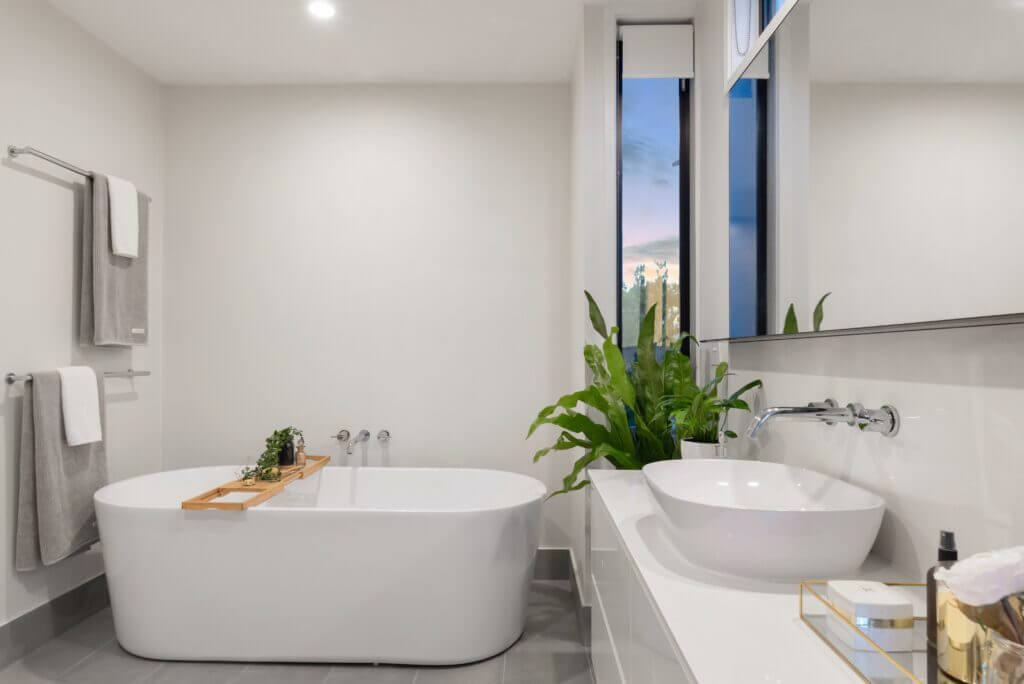
-
Pros
- Lightweight and easy to install
- Affordable
- Retains heat well
-
Cons
- Less durable than some other materials
- Can become discolored over time
Acrylic bathtubs are a popular choice due to their affordability, versatility, and ease of maintenance. Made from a lightweight and durable material, these bathtubs are resistant to chipping, cracking, and fading. Acrylic offers a smooth, non-porous surface, making it easy to clean and resistant to stains. Additionally, it retains heat well, providing a comfortable bathing experience.
Porcelain-Enameled Steel Tubs
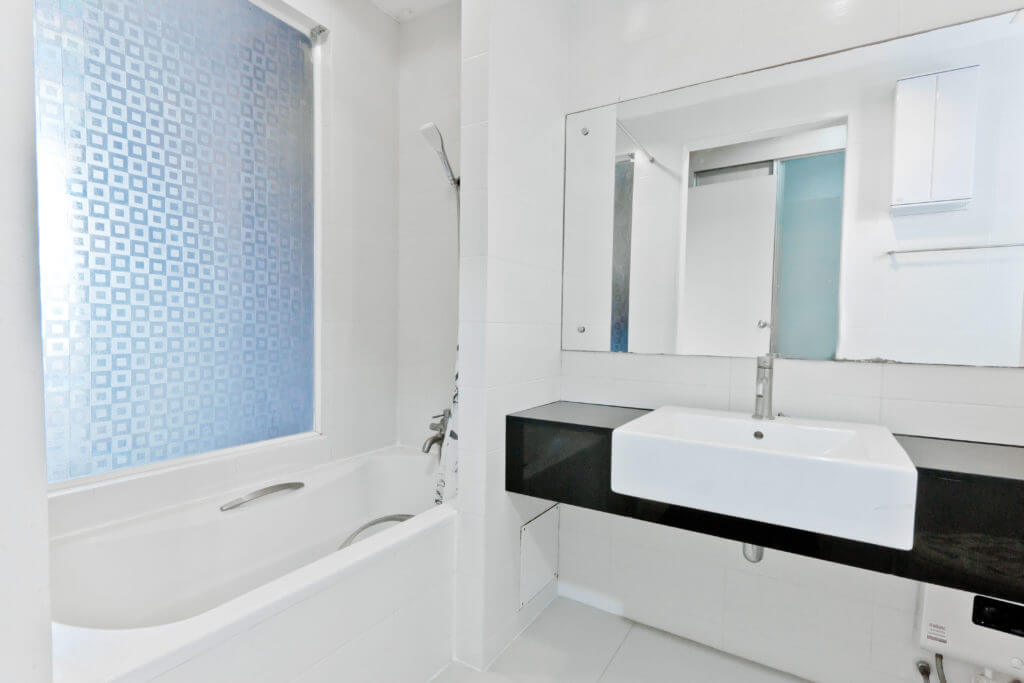
-
Pros
- Affordable
- Durable and easy to clean
- Glossy, sleek appearance
-
Cons
- Chips more easily than other materials
- Doesn’t retain as well as some other options
- Limited in shape and size choices
Porcelain-enameled steel bathtubs are constructed with a steel base coated with a layer of porcelain enamel. This combination results in a durable and affordable bathtub option. The glossy finish of the porcelain enamel gives these tubs a sleek and modern appearance, while the steel base provides strength and stability. However, they may not retain heat as effectively as other materials and can be susceptible to chipping and scratching if not properly maintained.
Fiberglass Bathtubs
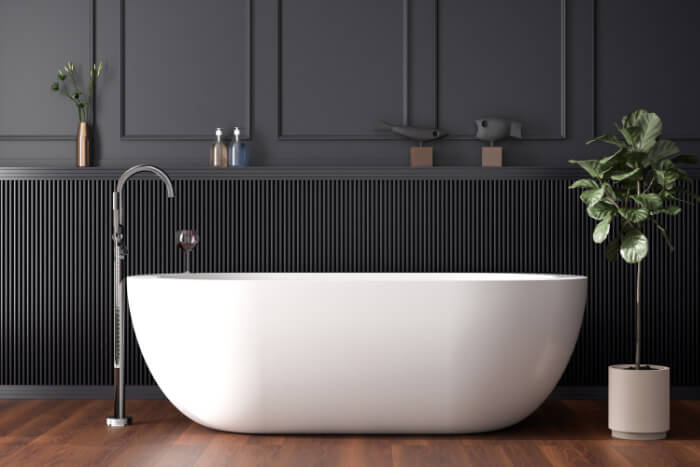
-
Pros
- Most affordable option
- Easy to install since it’s so light
- Can be molded into many shapes and styles
-
Cons
- Not as durable as some other options
- Surface can scratch easily
Fiberglass bathtubs are another cost-effective option for homeowners. These bathtubs are made from reinforced plastic that is lightweight yet sturdy. They are available in a variety of shapes, sizes, and colors, making them highly customizable to fit your bathroom decor. However, it’s important to note that fiberglass can be prone to scratching and may require regular maintenance to retain its appearance and structural integrity.
Cast Iron Bathtubs
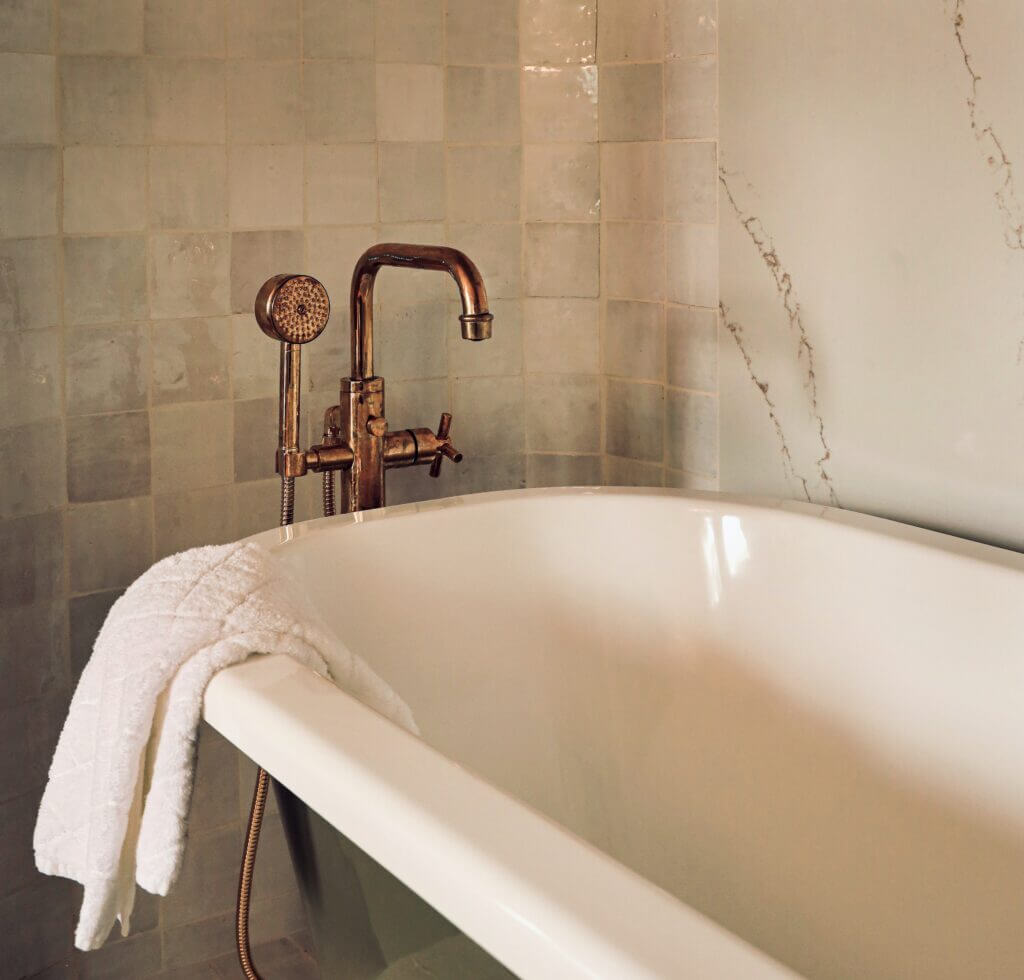
-
Pros
- Extremely durable
- Classic, high-quality appearance
- Excellent heat retention
-
Cons
- Very heavy, so may require additional floor support
- More expensive than many other options
- Limited color and shape choices
For those seeking a timeless and luxurious bathing experience, cast iron bathtubs are an excellent choice. These bathtubs are incredibly durable and provide exceptional heat retention. The heavy construction of cast iron ensures longevity, but it also means they require proper structural support during installation. While cast iron bathtubs can be a bit more expensive, their classic beauty and durability make them a worthwhile investment.
Stone Resin Tubs
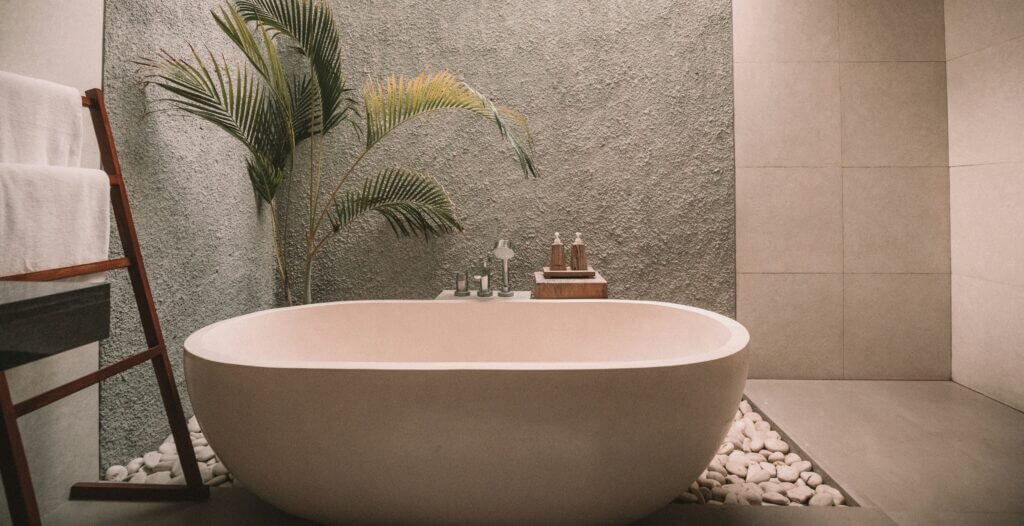
-
Pros
- Mimics the look and feel of real stone
- Retains heat well and is durable
- Comes in lots of shapes and finishes
-
Cons
- Lighter than real stone but still heavier than some other materials
- Can become quite expensive
Stone resin tubs are made by combining natural stone with acrylic polymer and then molding them into tub shapes. This process creates a material that mimics the appearance and feel of solid stone but is more affordable and lighter in weight. The result is a luxurious, contemporary bathtub that can serve as the focal point of any bathroom design.
Solid Surface Bathtubs
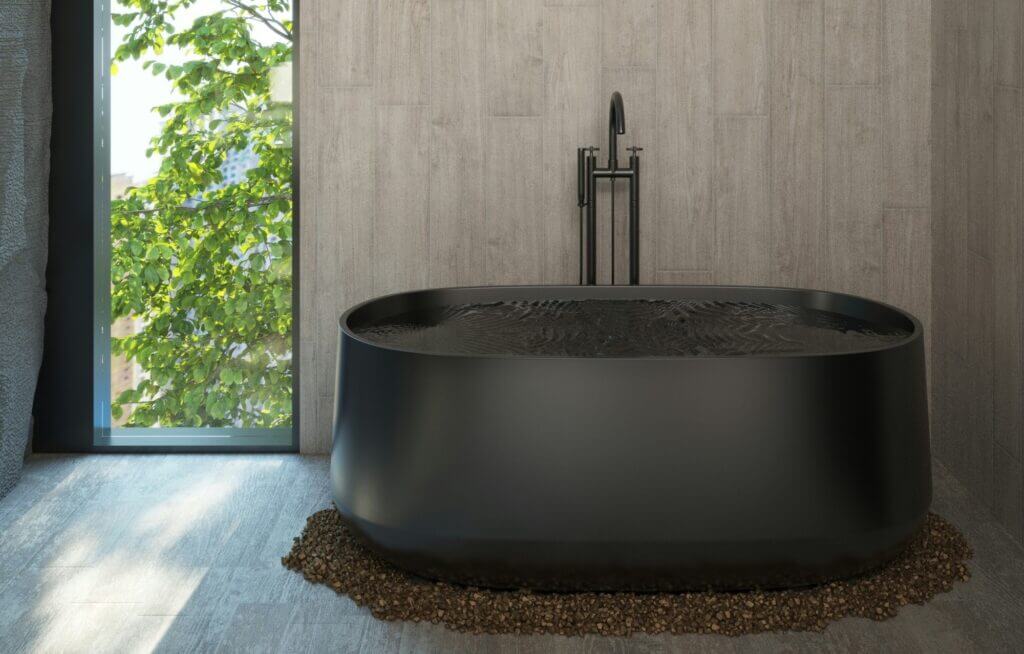
-
Pros
- Customizable shapes and colors
- Easy to clean and maintain
- Modern look and feel
-
Cons
- Can be expensive
- Can be more difficult to install
Solid surface bathtubs are crafted from a composite material made of crushed stone, acrylic, and resin. This material offers a seamless, non-porous surface that is highly resistant to stains and scratches. Solid surface bathtubs come in a wide range of designs and finishes, allowing for creative freedom in bathroom design. They are known for their excellent heat retention and are relatively easy to maintain.
Copper Bathtubs
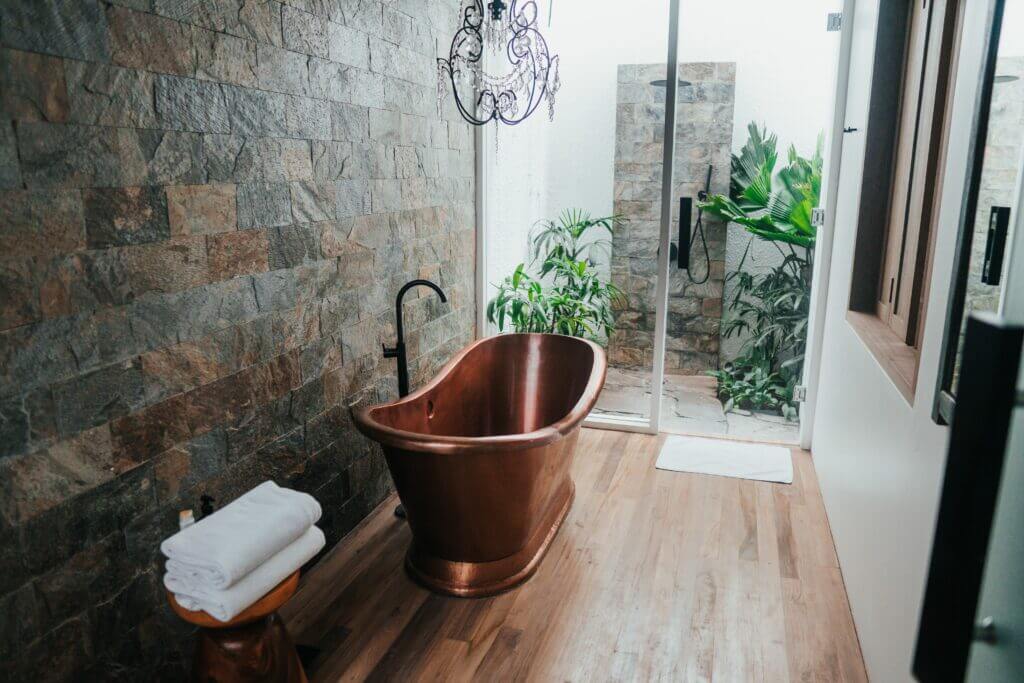
-
Pros
- Distinct, luxurious appearance
- Naturally resistant to bacteria
- Extremely durable with excellent longevity
-
Cons
- High cost
- Requires regular maintenance to preserve appearance
If you desire a luxurious and distinctive bathing experience, copper bathtubs are a unique choice. These bathtubs exude elegance and can serve as a focal point in your bathroom. Copper naturally resists bacteria and is known for its heat retention properties, ensuring a warm and indulgent soak. However, copper bathtubs require regular maintenance to prevent tarnishing and may be more expensive compared to other options.
Cultured Marble Tubs

-
Pros
- Mimics the look of marble
- Less expensive than real marble
- Comes in lots of colors and patterns
-
Cons
- Can scratch and stain more easily than other materials
- Not as durable as natural stone
- May not feel exactly like marble
Cultured marble tubs are made from crushed limestone mixed with resin, then coated with a gel to create a smooth, glossy surface. This manufacturing process allows for a variety of shapes, sizes, and colors, offering the luxurious appearance of marble at a more accessible price point. It also reduces the overall weight of the tub, making it possible to install without subfloor reinforcements in many cases.
Bathtub Costs by Material
The cost of your bathtub replacement project will vary by the materials you choose in addition to the size, quality, and brand. There are high-end materials that are extremely durable but will cost more, and there are also more basic tub materials that have average durability and butare more budget-friendly.
You can explore the average cost of a tub based on bathtub materials in our table below.
| Material | Average Cost |
|---|---|
| Acrylic | $500 - $2,000 |
| Porcelain-Enameled Steel | $300 - $1,500 |
| Fiberglass (FRP) | $200 - $800 |
| Cast Iron | $500 - $2,500+ |
| Stone Resin | $2,000 - $7,000+ |
| Solid Surface | $1,800 - $5,000+ |
| Copper | $2,000 - $10,000+ |
| Cultured Marble | $1,500 - $4,000 |
Tips for Choosing the Best Bathtub Material
When it comes to choosing the best bathtub material for your home, we recommend considering the key factors outlined below.
Durability
- For the most durable tub, choose: Acrylic or cast iron
Durability is a crucial factor to consider when choosing a bathtub material for several reasons. Firstly, a durable bathtub ensures longevity, meaning it will withstand daily use, resist wear and tear, and maintain its structural integrity over time. This helps prevent frequent repairs or replacements, saving you money and hassle in the long run. Additionally, a durable bathtub material is less prone to cracking, chipping, or fading, ensuring that it remains an attractive feature in your bathroom. Lastly, a durable bathtub provides a safe bathing experience, giving you peace of mind and ensuring the comfort and satisfaction of your household members.
Weight
- For the lowest weight tub, choose: Acrylic or fiberglass
The weight of a bathtub material plays a significant role in its installation, structural requirements, and overall functionality.
Lightweight bathtub materials, such as acrylic and fiberglass, are easier to install compared to heavier options like cast iron. Their lighter weight eases the installation process, reduces labor costs, and minimizes the need for additional structural support.
Heavier bathtubs require proper reinforcement and support to ensure they can bear the load. Cast iron bathtubs may necessitate floor reinforcement to accommodate their weight, impacting the overall bathroom renovation process and cost.
Lighter bathtubs are more flexible when it comes to remodeling or repositioning. They can be moved or replaced with ease, providing more flexibility for future bathroom modifications or renovations. Lighter bathtubs are also easier to maneuver and can be a more accessible option for those who require assistance or use mobility aids.
Maintenance Requirements
- For the easiest-to-clean tub, choose: Solid surface or porcelain-enameled steel
Considering the maintenance requirements of a bathtub material is important before buying because maintenance prolongs the tub’s lifespan. You want to choose a bathtub material that fits with your desired level of upkeep commitment, ensuring it remains in excellent condition for years to come.
Regular maintenance also reserves the visual appeal of the bathtub. Some materials may require specific cleaning agents or methods to prevent staining, discoloration, or damage. Knowing and adhering to these maintenance guidelines helps maintain the bathtub’s original beauty and prevents unsightly blemishes.
When it comes to hygiene and health, maintaining cleanliness is essential for a healthy bathing environment. Certain materials may be more susceptible to mold, mildew, or bacterial growth. Understanding the cleaning and disinfection requirements of a bathtub material allows you to ensure a hygienic bathing experience for you and your family.
Lastly, maintenance requirements can impact your budget over time. Some materials may require more frequent or specialized maintenance, such as refinishing or sealing, which may incur additional expenses. Considering the long-term maintenance costs associated with a particular material helps you make an informed decision based on your budgetary constraints.
Cost
- For the cheapest tub, choose: Fiberglass or porcelain-enameled steel
Considering the cost of a bathtub material is essential for several reasons:
Budget Limitations
Cost is a practical consideration that helps you stay within your allocated budget for the bathtub replacement project. Understanding the price range of different materials allows you to make an informed decision and avoid unexpected financial strain.
Value for Money
Evaluating the cost of a bathtub material in relation to its durability, longevity, and maintenance requirements helps you assess its overall value. A higher-priced material may offer superior quality and longevity, making it a worthwhile investment in the long run.
Affordability and Accessibility
Different homeowners have different financial circumstances. Cost considerations ensure that you can choose a bathtub material that aligns with your affordability and accessibility requirements, allowing you to enjoy a functional and stylish bathtub without compromising your financial well-being.
Return on Investment
Cost is a factor in the potential return on investment for your home. A well-chosen, high-quality bathtub material can enhance your home’s value and appeal if you plan to sell or rent your property in the future.
Aesthetic Appeal
- For the most striking appearance, choose: Copper or stone resin
Aesthetic appeal is a significant consideration when choosing a bathtub material. Your bathroom should reflect your taste and style. The bathtub is a focal point that contributes to the overall look. Choosing a material that matches your desired aesthetic enhances the bathroom’s visual harmony.
A visually appealing bathtub also adds value to your home. Buyers and renters are attracted to bathrooms with pleasing aesthetics. A well-chosen material that complements the bathroom design increases the appeal and marketability of your home.
Considering the aesthetic appeal of a bathtub material helps you select one that matches your style, enhances the bathroom’s design, increases home value, and creates a visually appealing and emotionally satisfying bathing environment.
Finding a Contractor
Before you start looking for the right professional to install your new tub, we recommend you:
- Have a good understanding of what’s involved in this renovation project. Read our guide to bathtub remodeling for more information.
- Have a sense of what style of bathtub you want in addition to what material you want. Check out our guide to types of bathtubs to see your options.
- Know what size tub you currently have (if you have one already) and what size tub you ideally want. Our guide to standard bathtub sizes can tell you more.
Once you have a good sense of what all your options are and what you may want for your own bathroom, it’s time to get quotes.
We always recommend getting three to four quotes – no matter what home improvement project you’re pursuing – to find the best price as well as to find the right professional you will click with.
You can browse our contractor directory to see pros in your area and request free quotes, or you can have us do the legwork for you. Click below to answer a few questions about your project, and we’ll match you with up to four contractors.
Compare top-rated bathroom remodel pros in your area.
Read real homeowner reviews, explore qualifications, and view promotions. Modernize makes it easy to browse professionals and find one that will be perfect for your project.



